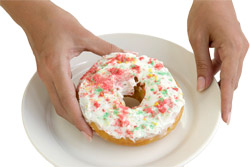- Introduction to comfort eating
- Eating styles
- Types of comfort foods
- Brain food
- Psychological issues
- Choosing healthy comfort foods
Introduction to comfort eating
Often when food is eaten, it is not just for the nutritional content or to appease hunger, but also for social or psychological reasons. Eating a meal can change your mood and emotional predisposition. In general, it reduces arousal and irritability while increasing calmness. This effect depends on the meal size and composition being close to what you want, what you are used to, and what you need. Comfort eating is a way in which people deal with stress, anxiety, boredom, loneliness or unhappiness. Comfort foods are foods that evoke a psychologically comfortable and pleasurable state when they are eaten.
Eating styles
There are a number of eating styles:
- Restrained eating (dieting): Consciously restricting food and calorie intake as a way of controlling body weight;
- Restrictive/overeating: Chronic dieting produces feelings of hunger and deprivation, leading to episodes of overeating and weight gain;
- Emotional eating (comfort eating): Eating in response to negative states such as depression or loneliness;
- External eating: Increased eating due to external stimuli such as seeing, smelling or tasting food;
- Snacking/grazing: Consuming high energy food and drinks between meals, and sometimes replacing meals.
Types of comfort foods

What you prefer to eat can be influenced by social context, social identification and conditioned responses. For example, chocolate is appealing not only because it tastes good, but also because it evokes a positive connection with receiving chocolate as a child as either gifts or rewards.
Environmental cues can cause people to eat even when they are not hungry. This is common and expected in some cases like dinner parties. Think about going to the cinema and buying a big tub of popcorn, or eating lunch just because it’s lunchtime.
Soft drink consumption is related to more emotional and external eating. Generally, those who drink soft drinks have a lower education, lower incomes, less healthy lifestyles, eat more sugar, and exercise less.
Brain food
Eating when hungry is both pleasurable and rewarding, an effect in the brain mediated by neurotransmitters (dopamine, opioids and benzodiazepine). Dopamine affects how much you want to eat, whereas the opioids and benzodiazepine affect how much you like what you are eating. The opioid neurotransmitter system is also involved in how you respond to stress and agitation. This is especially apparent in babies: giving sweet and fatty foods (including milk) to infants will sooth their crying and other distress signs.
The soothing affect of sweet foods depends on the taste rather than the sugar content. Artificially sweetened foods will work just as well as high sugar foods. As you get older, your mood becomes less affected by sweet foods, although many people still prefer chocolate and other sugary comfort foods. However, the more you eat sugary and fatty foods for comfort, the less they comfort you. Repeatedly eating lots of these foods downregulates the neurotransmitter pathways (i.e. more effort is needed to achieve the same effect). For this reason, obese people get less enjoyment out of the same amount of comfort food as non-obese people.
Psychological issues
People comfort eat all the time. How much they eat for comfort depends on a number of factors, including gender, weight, psychological issues and emotional state.
Stress

Emotional eaters under stress will choose sweeter, high-fat foods such as chocolate and cake. Their meals will also be higher in energy. It has been suggested that emotional eaters may, in fact, be more susceptible to the effects of stress. Women who ate more snack foods when stressed showed a greater release of the stress sensitive hormone cortisol than non-emotional eaters. These types of foods caused them to feel less healthy and more guilty.
Adolescence
Puberty, changing body shape, new sexual feelings and risk-taking urges can all affect an adolescent’s eating patterns. Exercise can decrease appetite and lighten mood; in general, girls in high school start doing less exercise, while boys start doing more. Social pressures, media images and competitive product marketing may distort an adolescent’s ideas of body image, particularly about beauty and weight. Social pressures and the portrayal of unrealistically thin bodies as ‘beautiful’ may give adolescents a skewed perspective on body image, particularly in regards to physical attractiveness and weight. Adolescents are at a greater risk of developing disordered patterns of eating and eating disorders such as anorexia, bulimia or binge eating.
Comfort eating involves similar eating patterns to binge eating. Both are disordered patterns of eating that involve consumption of food when the individual is not hungry. As less serious forms of disordered eating are associated with the future development of serious eating disorders such as anorexia nervosa and bulimia nervosa (and these disorders are most common amongst adolescents), binge and comfort eating in adolescence may also be related to the social pressures adolescents face to attain unrealistic thinness.
Obesity
The way that you eat affects your body weight. Obesity (BMI ≥ 30 kg/m2) is associated with restrictive/overeating, comfort eating, snacking, eating in the evening, and with an inability to maintain a healthy eating pattern. Obese women comfort eat more often than non-obese women. Obese people may comfort eat because they are feeling depressed, anxious or guilty, or have low self-esteem. These feelings are often caused by social stigmatisation, dissatisfaction with their bodies, and physical discomfort due to their obesity. Physical discomfort may discourage them from exercising. This combination of increased energy intake (from comfort foods) and reduced energy output (from lack of exercise) causes them to gain more weight. Some medications used to treat their psychological condition (e.g. psychotropic drugs) also tend to cause weight gain.
Choosing healthy comfort foods

- People are either not aware of or do not use the nutritional content of foods when deciding how healthy they are;
- Beliefs about the healthiness of a food are not related to how often it is eaten; and
- Taste is more often important than healthiness value when choosing foods.
Considering the health benefits of a nutritious diet and the health risks of an unhealthy diet, the lack of attention most people pay to the nutritional content of food is disturbing. In relation to comfort eating, many people could benefit from making healthier comfort eating choices, with less emphasis on the taste of the food and more emphasis on its nutritional content.
Research suggests that the reward gained from comfort foods seems to be based on taste rather than nutritional content, and that individuals can obtain the same ‘comfort’ by eating a healthy nutritious snack as they do eating an unhealthy snack. If you are unable to stop comfort eating altogether, choosing healthy foods for your comfort snacks is a good option. For example, why not:
- Have a piece of fruit instead of a lolly;
- Make a healthy smoothie using a banana or strawberries and low fat milk;
- Eat small portions of nuts or dried fruit for a snack; or
- Munch on carrot or celery sticks when not hungry but in need of a snack. These foods give you a lift without filling you up.
In the long run, choosing nutritious comfort foods will be healthier and make you feel better.
More information
 |
For more information on nutrition, including information on types and composition of food, nutrition and people, conditions related to nutrition, and diets and recipes, as well as some useful videos and tools, see Nutrition. |
 |
For more information on obesity, health and social issues, and methods of weight loss, as well as some useful tools, seeObesity and Weight Loss. |
References
- Gibson EL. Emotional influences on food choice: Sensory, physiological and psychological pathways. Physiol Behav. 2006;89(1):53-61. [Abstract]
- Wansink B, Cheney MM, Chan N. Exploring comfort food preferences across age and gender. Physiol Behav. 2003;79(4-5):739-47. [Abstract]
- Bernstein IL. Development of taste preferences. In: Bolles RC (ed). The Hedonics of Taste. Hillsdale, NJ: Lawrence Erlbaum Associates; 1991: p 143-57. [Book]
- Barthel D. Modernism and marketing: The chocolate box revisited. Theory Cult Soc. 1989;6(3):429-38. [Abstract]
- Tuomisto T, Tuomisto MT, Hetherington M, Lappalainen R. Reasons for initiation and cessation of eating in obese men and women and the affective consequence of eating in everyday situations. Appetite. 1998;30(2):211-22. [Abstract]
- Elfhag K, Tynelius P, Rasmussen F. Sugar-sweetened and artificially sweetened soft drinks in association to restrained, external and emotional eating. Physiol Behav. 2007;91(2-3):191-5. [Abstract]
- Vereecken CA, Inchley J, Subramanian SV, et al. The relative influence of individual and contextual socio-economic status on consumption of fruit and soft drinks among adolescents in Europe. Eur J Public Health. 2005;15(3):224-32. [Abstract | Full text]
- Kvaavik E, Andersen LF, Klepp KI. The stability of soft drinks intake from adolescence to adult age and the association between long-term consumption of soft drinks and lifestyle factors and body weight. Public Health Nutr. 2005;8(2):149-57. [Abstract | Full text]
- Keski-Rahkonen A, Bulik CM, Pietiläinen KH, et al. Eating styles, overweight and obesity in young adult twins. Eur J Clin Nutr. 2007;61(7):822-9. [Abstract | Full text]
- Polivy J, Herman CP, McFarlane T. Effects of anxiety on eating: Does palatability moderate distress-induced overeating in dieters? J Abnorm Psychol. 1994;103(3):505-10. [Abstract]
- Swinburn B, Egger G. The runaway weight gain train: too many accelerators, not enough brakes. BMJ. 2004;329(7468):736-9. [Abstract | Full text]
- Epel E, Lapidus R, McEwen B, Brownell K. Stress may add bite to appetite in women: A laboratory study of stress-induced cortisol and eating behavior. Psychoneuroendocrinol. 2001;26(1):37-49. [Abstract]
- Wilhelm KA, Clarke SD. Eating disorders from a primary care perspective. Med J Aust. 19984;168(9):458-63. [Full text]
- Byrne A, Byrne DG. The effect of exercise on depression, anxiety and other mood states: A review. J Psychosom Res. 1993;37(6):565-74. [Abstract]
- Garner DM, Rosen LW. Eating disorders among athletes: Research and recommendations. J App Sports Sci. 1991;5(2):100-7. [Abstract]
- Berridge KC, Robinson TE. What is the role of dopamine in reward: Hedonic impact, reward learning, or incentive salience? Brain Res Rev. 1998;28(3):309-69. [Abstract]
- Kelley AE, Will MJ, Steininger TL, et al. Restricted daily consumption of a highly palatable food (chocolate Ensure®) alters striatal enkephalin gene expression. Eur J Neurosci. 2003;18(9):2592-8. [Abstract]
- Aikman SN, Min KE, Graham D. Food attitudes, eating behavior, and the information underlying food attitudes. Appetite. 2006;47(1):111-4. [Abstract]
- The Australian guide to healthy eating [online]. Canberra, ACT: Australian Government Department of Health and Ageing; 2008 [cited 27 January 2011]. Available from: URL link
- Mühlhäusler BS, Adam CL, McMillen IC. Maternal nutrition and the programming of obesity: The brain. Organogenesis. 2008;4(3):144-52. [Abstract | Full text]
- Body image and disordered eating [online]. Sacramento, CA: California Department of Public Health; July 2000 [cited 27 January 2011]. Available from: URL link
Related Diseases:
All content and media on the HealthEngine Blog is created and published online for informational purposes only. It is not intended to be a substitute for professional medical advice and should not be relied on as health or personal advice. Always seek the guidance of your doctor or other qualified health professional with any questions you may have regarding your health or a medical condition. Never disregard the advice of a medical professional, or delay in seeking it because of something you have read on this Website. If you think you may have a medical emergency, call your doctor, go to the nearest hospital emergency department, or call the emergency services immediately.







